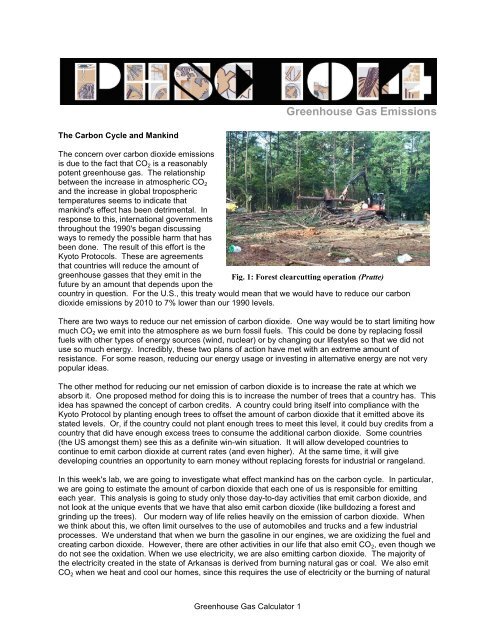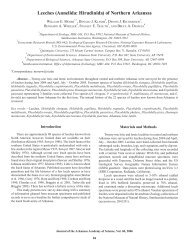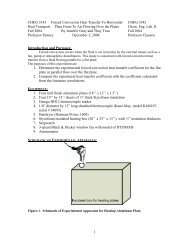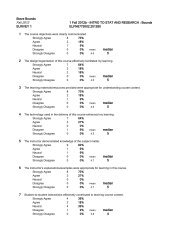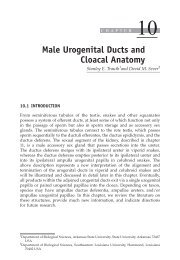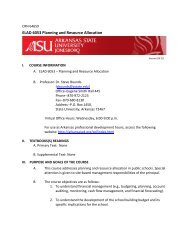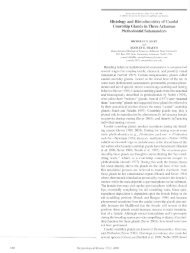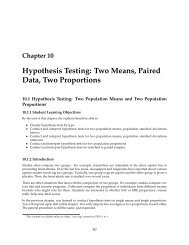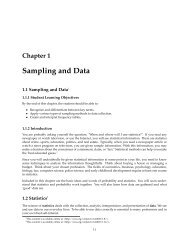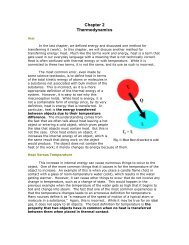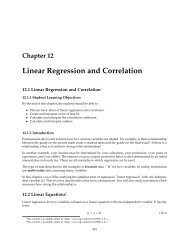Carbon Output (.PDF) - Arkansas State University
Carbon Output (.PDF) - Arkansas State University
Carbon Output (.PDF) - Arkansas State University
Create successful ePaper yourself
Turn your PDF publications into a flip-book with our unique Google optimized e-Paper software.
The <strong>Carbon</strong> Cycle and Mankind<br />
Greenhouse Gas Calculator 1<br />
Greenhouse Gas Emissions<br />
The concern over carbon dioxide emissions<br />
is due to the fact that CO2 is a reasonably<br />
potent greenhouse gas. The relationship<br />
between the increase in atmospheric CO2<br />
and the increase in global tropospheric<br />
temperatures seems to indicate that<br />
mankind's effect has been detrimental. In<br />
response to this, international governments<br />
throughout the 1990's began discussing<br />
ways to remedy the possible harm that has<br />
been done. The result of this effort is the<br />
Kyoto Protocols. These are agreements<br />
that countries will reduce the amount of<br />
greenhouse gasses that they emit in the Fig. 1: Forest clearcutting operation (Pratte)<br />
future by an amount that depends upon the<br />
country in question. For the U.S., this treaty would mean that we would have to reduce our carbon<br />
dioxide emissions by 2010 to 7% lower than our 1990 levels.<br />
There are two ways to reduce our net emission of carbon dioxide. One way would be to start limiting how<br />
much CO2 we emit into the atmosphere as we burn fossil fuels. This could be done by replacing fossil<br />
fuels with other types of energy sources (wind, nuclear) or by changing our lifestyles so that we did not<br />
use so much energy. Incredibly, these two plans of action have met with an extreme amount of<br />
resistance. For some reason, reducing our energy usage or investing in alternative energy are not very<br />
popular ideas.<br />
The other method for reducing our net emission of carbon dioxide is to increase the rate at which we<br />
absorb it. One proposed method for doing this is to increase the number of trees that a country has. This<br />
idea has spawned the concept of carbon credits. A country could bring itself into compliance with the<br />
Kyoto Protocol by planting enough trees to offset the amount of carbon dioxide that it emitted above its<br />
stated levels. Or, if the country could not plant enough trees to meet this level, it could buy credits from a<br />
country that did have enough excess trees to consume the additional carbon dioxide. Some countries<br />
(the US amongst them) see this as a definite win-win situation. It will allow developed countries to<br />
continue to emit carbon dioxide at current rates (and even higher). At the same time, it will give<br />
developing countries an opportunity to earn money without replacing forests for industrial or rangeland.<br />
In this week's lab, we are going to investigate what effect mankind has on the carbon cycle. In particular,<br />
we are going to estimate the amount of carbon dioxide that each one of us is responsible for emitting<br />
each year. This analysis is going to study only those day-to-day activities that emit carbon dioxide, and<br />
not look at the unique events that we have that also emit carbon dioxide (like bulldozing a forest and<br />
grinding up the trees). Our modern way of life relies heavily on the emission of carbon dioxide. When<br />
we think about this, we often limit ourselves to the use of automobiles and trucks and a few industrial<br />
processes. We understand that when we burn the gasoline in our engines, we are oxidizing the fuel and<br />
creating carbon dioxide. However, there are other activities in our life that also emit CO2, even though we<br />
do not see the oxidation. When we use electricity, we are also emitting carbon dioxide. The majority of<br />
the electricity created in the state of <strong>Arkansas</strong> is derived from burning natural gas or coal. We also emit<br />
CO2 when we heat and cool our homes, since this requires the use of electricity or the burning of natural
gas, propane, heating oil, or wood. Even our creation of garbage releases carbon dioxide in the<br />
environment. If this garbage is put into a landfill, it decays and puts CO2 back into the atmosphere. If it is<br />
recycled, energy of some form will be used to accomplish this, emitting CO2 in the process.<br />
Calculating Your Emissions of <strong>Carbon</strong> Dioxide<br />
Overview<br />
So how much carbon dioxide is emitted to the atmosphere through your daily activities? To answer this<br />
question, you will use an online Personal Greenhouse Gas Calculator developed by the U.S.<br />
Environmental Protection Agency (EPA). The calculator sums the carbon dioxide produced by your<br />
driving, electricity use, and waste disposal, and provides you with an estimate of your annual carbon<br />
dioxide emissions. The calculator then allows you to see how changes in your lifestyle could reduce your<br />
carbon dioxide emissions.<br />
Before you begin<br />
Americans tend to contribute a lot of carbon dioxide through driving, so it is therefore vitally important that<br />
you know your vehicle's gas mileage. To assist you, the US Department of Energy and EPA have created<br />
a web site that allows users to look up the gas mileage for any vehicle made from 1985 through the<br />
present. Your first step is to determine your vehicle's gas mileage from this site. After entering the year,<br />
make, and model of your vehicle, you will be provided with its city and highway gas mileage. For<br />
simplicity's sake, assume that half of the miles you drive are highway travel, and the other half are<br />
city/suburban travel unless your mileage patterns differ. To obtain a single value for gas mileage, simply<br />
use the average of the city and highway mileages listed.<br />
Vehicle Fuel Economy Resources<br />
Online database of vehicle fuel efficiencies<br />
U.S. Department of Energy<br />
http://www.fueleconomy.gov/<br />
Activity<br />
Complete the Personal Greenhouse Gas Calculator and enter the appropriate information in the Activity<br />
sheet. The use of the calculator is largely self-explanatory, so detailed directions will not be provided. A<br />
few comments, though:<br />
(1.) In the Transportation section, make sure you select the appropriate time frame (week or year) for your<br />
entered mileage.<br />
(2.) In the Home Energy section, enter the average of your summer and winter electric and gas bills.<br />
EPA's Personal Greenhouse Gas Calculator<br />
Allows users to analyze their emissions of CO2 and learn ways to reduce them<br />
U.S. Department of Energy<br />
http://www.epa.gov/climatechange/emissions/ind_calculator2.html<br />
The activity sheet will ask you to enter and analyze values from this first run of the calculator, and then<br />
use the subsequent section of the calculator to investigate how you can reduce your carbon dioxide<br />
emissions. When you have completed the exercise, print out a copy of the calculator and attach it to the<br />
Activity sheet. Prior to printing, make sure the values in the Your Current Emissions section are your<br />
original values from the first run of the calculator.<br />
A portion of the activity asks you to consider the change from a conventional vehicle to a more efficient<br />
gasoline-powered "hybrid" vehicle. To learn more about such vehicles, visit the link below.<br />
Alternative and Advanced Vehicle Program<br />
Information about hybrid and alternative vehicles<br />
U.S. Department of Energy<br />
http://www.eere.energy.gov/afdc/vehicles/hybrid_electric.html<br />
Greenhouse Gas Calculator 2
PHSC 1014<br />
Name:<br />
Greenhouse Gas Calculator: Personal Impacts 1<br />
Activity Sheet<br />
Greenhouse Gas Emissions<br />
Calculating your total emissions:<br />
Enter the values from the calculator in the table below and calculate the percent of total emissions for<br />
each.<br />
Transportation<br />
Category Lbs. of CO2 per year Percent of Total Emissions<br />
Home Energy - Electricity<br />
Home Energy - Natural Gas<br />
Home Energy - Fuel Oil<br />
Waste - Non recycled trash<br />
Total Annual Emissions<br />
Analysis:<br />
For each question below, fully explain your answer.<br />
In what category were your emissions highest? Does this surprise you?<br />
How did your household’s overall emissions compare with the average of 60,000 lbs. per year? Does the<br />
magnitude of your emissions surprise you?
Making Changes:<br />
If your results are typical, your emissions from Transportation comprised a significant amount of your<br />
overall emissions. Let’s see how a highly fuel efficient vehicle would affect your carbon dioxide<br />
contributions. A number of “hybrid” gasoline powered vehicles are currently available, and these vehicles<br />
get significantly higher mileage than conventional vehicles. One example is the 2006 Honda Insight,<br />
which has a combined (average of city and highway) fuel efficiency of 52 MPG. In the first part of the<br />
What You Can Do to Reduce Emissions section, enter the appropriate value to increase your current<br />
vehicle’s mileage to 52 MPG (enter the difference between your current MPG and 52 MPG). Hit the Tab<br />
key to register the change, and list the resultant reductions below. You can obtain the New CO2<br />
emissions by subtracting the “lbs CO2 avoided” from your previous total, or by scrolling down to the end<br />
of the calculator.<br />
Switching to hybrid vehicle<br />
Percent Reduction in CO2 New CO2 emissions<br />
After seeing the carbon reductions and visiting the web site on hybrid vehicles<br />
(http://www.eere.energy.gov/afdc/vehicles/hybrid_electric.html ), would you be willing to seriously<br />
investigate buying such a vehicle? Explain why or why not.<br />
Clear the preceding change in vehicle mileage by highlighting the value you entered, entering “0” in its<br />
place, and pressing the TAB key. Then proceed through the What You Can Do to Reduce Emissions<br />
section, and choose at least three options that you would be willing to embrace. If you need to enter<br />
values (more MPG, thermostat changes, etc.) make sure they are reasonable changes. List the three<br />
changes below and list the percent reductions in your total emissions that occurred as a result of each.<br />
Change Percent reduction in annual CO2 emissions<br />
Seeing the reductions in emissions that occur as a result of these changes, would you be willing to<br />
immediately implement any of them? Explain why or why not.<br />
Greenhouse Gas Calculator: Personal Impacts 2


